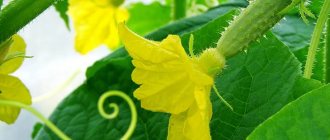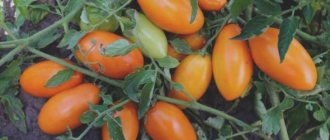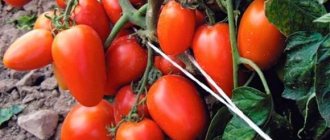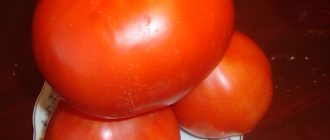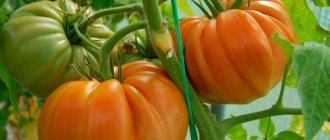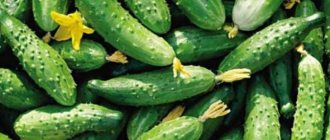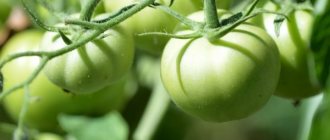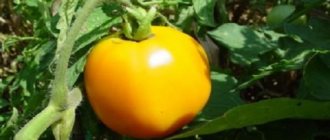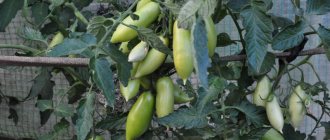Spring plays along with tomatoes. As a gift to gardeners, breeders offered Amber honey - a bright, beautiful variety with a wonderful taste. The pulp contains pleasant shades of honey sweetness. The fruits are highly valued for their ability to create delicious delicacies - light summer salads, sauces, pastes, juices.
| Height | Landing location | Ripening time | Fruit color | Fruit size | Origin | Fruit shape |
| Medium height | Greenhouse, Open ground | Mid-season | Orange | Average | Variety | Flat-round |
Characteristics and description of the tomato variety
The Amber Honey tomato is an indeterminate variety. Large flat-round fruits acquire a bright orange color as they ripen. The weight of a tomato varies from 90 to 200 g. Under optimal growing conditions, the weight of tomatoes can reach 400 g.
The bush of the plant is medium-leafed, with thin branches that need staking. The leaves of the plant are small, potato-type.
Tomato Amber honey is classified as a mid-season variety. Fruit ripening from the moment of germination occurs after 110 - 120 days. In the middle zone, the variety is recommended for growing in greenhouse conditions. In southern regions with warm climates, tomatoes ripen in open ground.
Heart of Ashgabat: old variety of tomatoes with large orange fruits
Now a huge number of varieties and hybrids of tomatoes have been bred, but gardeners do not refuse many well-deserved ones, grown for half a century. One of the old varieties that has not lost its fans is the Heart of Ashgabat tomato, which bears bright yellow fruits.
History of tomato cultivation Heart of Ashgabat
The Heart of Ashgabat tomato is considered a variety of folk selection, bred in the Turkmen SSR in the 1960s. and quickly became popular among gardeners of that era. It is known that the variety received state registration in 1972, but currently there is no entry about it in the State Register of Breeding Achievements of the Russian Federation.
Most often, the Heart of Ashgabat variety is grown in the southern regions, which is not surprising, but in protected soil it can grow well and bear fruit throughout our country. It has become especially easy to grow it with the advent of modern polycarbonate greenhouses. In regions such as the Astrakhan and Rostov regions, Stavropol region, Crimea, and the Heart of Ashgabat, they are successfully grown in open ground.
Description of the variety Heart of Ashgabat
The Heart of Ashgabat tomato is considered a semi-determinate standard variety; its bush grows up to one and a half meters high. The foliage is average. The formation of a bush is mandatory; usually it is grown in 2 or 3 stems, tying them to supports. 4 plants are kept per square meter. The variety is slightly affected by late blight and other tomato diseases, but during periods of prolonged rain the fruits are prone to cracking.
Not all fruits are the same in size, even the shape can vary
The variety is considered mid-early: the first fruits ripen 100–110 days after sowing the seeds for seedlings or, in the south, directly into the garden bed. Productivity is above average: up to 7 kg of tomatoes are harvested from one bush.
As the name suggests, the fruits are heart-shaped. They are quite large: on average they grow up to 300–400 g, but the first tomatoes on the bush can reach up to half a kilogram and contain 6 or 7 chambers. The color is bright yellow, closer to orange when fully ripe. Tomatoes store well and are suitable for transportation over medium distances.
The number of seeds is small, the pulp is fleshy, aromatic, very good taste, sweetish, practically without sourness. Some gardeners call the Heart of Ashgabat one of the best yellow-fruited varieties. The purpose is salad, but in addition to fresh consumption, the fruits are also suitable for processing. Whole-fruit canning in jars is difficult due to the size of tomatoes, so yellow tomato juice is mainly prepared from them. The fruits are suitable for producing a dried product. The variety is recommended for dietary nutrition.
The most suitable characteristic of fruits is “one meat”
Advantages and disadvantages compared to other similar varieties
The fact that many gardeners have been interested in this variety for half a century, and this interest has only been growing in recent years, testifies to the great potential that breeders have built into it. Seeds in bags are sold in 7-10 pieces and do not cost a penny at all. The variety has the following advantages:
- good yield;
- excellent taste of fruits;
- long-term preservation and good transportability;
- resistance to major diseases;
- beautiful appearance.
As relative disadvantages, they note the need to form a bush and the increased heat-loving nature of the variety, which does not allow it to be grown in the middle zone and in the north without shelter.
The number of tomato varieties is currently huge, many of them bearing yellow tomatoes, as well as those with heart-shaped fruits. But there were not many varieties that combine these two characteristics at the same time. Thus, tomatoes Bull's heart orange and Bull's heart amber have similar characteristics, and Bull's heart golden is characterized by excellent fruit taste and high yield, but is late-ripening. The Golden Heart tomato is early ripening, but its fruits weigh only 100 g, so they are used in whole-fruit canning.
The orange Honey Heart tomato also has rather small fruits, but the taste is characterized as excellent. The Orange Heart variety is also popular, bearing small fruits of excellent taste that retain their qualities during long-term storage. Thus, recently many varieties have been created that are similar to the Heart of Ashgabat and are its worthy competitors.
Agricultural technology tomato Amber honey
Amber honey tomatoes are recommended to be grown in greenhouses. In regions with warm climates, temporary shelters can be used in spring and early summer.
Growing seedlings
The seedling method of growing tomatoes is used everywhere. To obtain healthy seedlings, seeds are sown no later than mid-March. For sowing, you can select a special soil recommended for tomatoes. It usually contains at least 50% turf soil, sand, peat and a full range of microelements.
The acidity of the soil for tomato seedlings should not exceed 6.5. You can also prepare your own soil mixture at home by mixing and disinfecting all the components.
Seeds must be soaked for several hours before sowing in a weak solution of potassium permanganate or special preparations for seed treatment.
- Fill the container with soil mixture to half the volume.
- Moisturize.
- Place the seeds at a distance of 1 - 1.5 cm from each other.
- Apply a 1 cm layer of soil.
- Cover with film.
- Place in a warm place where the air temperature is 20 - 24 o
Tomato shoots appear in 7 - 10 days. To prevent the soil from compacting during seed germination, watering should be done through a tray.
Advice! Overdrying of the soil before germination can be avoided by pouring regular snow on top of the soil and compacting it.
When the first shoots appear, move the pots to a brightly lit place. It is recommended to plant young plants when 2–3 true leaves form. Picking is carried out in a container with a volume of up to 0.5 liters filled with soil one third of the way.
During the entire period before planting tomatoes in a permanent place, it is important to monitor the moisture content of the soil mixture. For tomato seedlings, it is recommended to carry out at least two fertilizings with complex fertilizer.
To develop a full-fledged root system, it is necessary to pour soil into the containers in several stages with an interval of 2 weeks.
Landing rules
Before planting seedlings in a greenhouse, hardening should be carried out. The room temperature should be reduced gradually. You can open the window for a while for 2 - 3 days. If the weather permits, the pots with seedlings are taken out onto the balcony or into a ventilated greenhouse.
In the greenhouse, you need to loosen the soil to a depth of 30 cm. Add rotted manure or compost and a complex of minerals (potassium, phosphorus).
Tomato planting option:
- It is necessary to prepare holes about 20 - 25 cm deep.
- For Amber Honey tomatoes, it is recommended to place the holes at a distance of 30 -40 cm in the row. The distance between the rows should be at least 60 cm. Between the beds - from 60 to 80 cm.
- Before planting the seedlings, pour the holes generously with warm water.
- The plant should be freed from the clod of earth and the middle (thick) root should be shortened by a third.
- If the light is too bright, it is recommended to shade young plants until they are completely rooted.
Watering and fertilizing
The first two weeks after planting, the seedlings are watered daily. The variety is very sensitive to growing conditions and does not tolerate heat. It is especially important in the greenhouse to observe the regime of watering and ventilation during the period of flowering and formation of ovaries.
It is advisable to fertilize and feed plants with complex preparations recommended for large-fruited tomato varieties. The product must contain potassium, phosphorus, molybdenum, boron and iodine. The first fertilizing should be done 2 weeks after planting the tomatoes in the greenhouse. When the ovaries appear, you can fertilize the tomatoes with a solution of wood ash and humus.
Experienced gardeners recommend watering with a yeast solution during the ripening period of tomatoes. An infusion prepared from 100 g of yeast per bucket of water will help increase the weight of the fruit.
Pinching and tying
When tomatoes grow above 30 cm from the soil level, the plants require a garter, since the peculiarity of the variety is thin branches that are not able to withstand the weight of the fruit on their own.
Pruning should be carried out from the moment the crop is planted. The bush tolerates the removal of small stepsons easily. Side shoots must be removed at least once every 10 days. Otherwise, overgrown stepsons will reduce the yield. And when large shoots are removed, the plant may experience stress, as a result of which growth will slow down.
Advice! To avoid re-growth of stepsons in place of the removed ones, you need to leave a small stump (5 - 7 mm).
Formation
To obtain maximum yield, bushes of the Amber honey variety are formed into 2 trunks. To do this, the top of the plant should be pinched above the fourth leaf with the ovary. The number of brushes should not exceed 6 pieces on each trunk. Underdeveloped flower brushes should be removed.
You can learn about the intricacies of tomato formation from the video:
Protection from diseases and pests
The hybrid variety Amber Honey is resistant to late blight and most fungal diseases of tomatoes. As a preventive measure, tomatoes in a greenhouse can be treated with Bordeaux mixture: this drug is suitable for protecting plants from a complex of fungal diseases.
Pest control products are used as needed, depending on the specific insect affecting plant development.
Features of cultivation and storage
Every tomato has its place. The variety bears fruit excellently in open beds and in temporary shelters. It is grown throughout the country from the northern to the southern regions.
5-6 bushes are planted per 1 m2. Make sure that the distance between the holes is no closer than 30 cm. The optimal depth of the holes is 30 cm.
It is important to maintain balance when watering so as not to over-moisten the soil and cause rot. The amount of liquid for 1 time per 1 root is 5-7 l
How to maximize your yield:
- Feed the bushes with complex formulations “Kemira”, “Agricola”, “Agrofit”.
- Mulch the beds with a thicker layer of straw.
- Periodically water with bio-infusions with the addition of probiotics.
Recommended tomato varieties
Completely complete User rating: 5/5
Full jug User rating: 4/5
Grandma's Kiss User rating: 5/5
Appetizing User rating: 5/5
Recommendations and opinions of vegetable growers
Reviews from vegetable growers indicate the versatility of using tomatoes and their bright, rich taste.
Evgenia Dobrolyubova, 57 years old, Volgograd:
“For many years I have been interested in growing tomatoes in a greenhouse, so I often experiment with varieties. Among my friends I heard positive reviews about the Amber Honey tomato. They noted the delicate taste of the fleshy fruits and the ease of caring for the crop. I bought seeds and planted them in pots.
After picking, the plants became stronger, and in mid-May the planting material was transferred to the ground. The soil under the bushes was mulched using a special fiber. Convenient because the moisture is distributed evenly and the air passes to the roots. The result is amazing; we managed to collect a good harvest of honey fruits.”
Anatoly Antonov, 62 years old, Pyatigorsk:
“I talked with my neighbors in the country and heard positive reviews about the Amber Honey tomato. I grew the crop from seeds last year. The seeds were planted in mid-March, and after 2 months the formed planting material was transferred to open ground. The plant took root well, did not get sick, and over the entire period bushes formed slightly taller than 1 m. I collected a decent harvest of large honey tomatoes.”
Antonina Ivanova, 49 years old, Omsk:
“I planted the Amber Honey tomato in a greenhouse. The plant is growing well and the first ovaries are soon forming. The leaf of the crop is the same shape as that of a potato, only smaller in size. Fruits with a honey smell and taste."
- Author: Maria Sukhorukikh
Rate this article:
- 5
- 4
- 3
- 2
- 1
(0 votes, average: 0 out of 5)
Share with your friends!
Fruit characteristics
Description:
- The fruits have a flat-round shape, slightly ribbed at the stalk.
- The weight of each varies between 150 -300 g.
- The earth salt of ripe tomatoes has a rich golden orange or bright yellow hue.
- They have only a few seed chambers - about four.
- Their skin is thin, but very dense, and does not crack easily.
- When ripe, the fruits acquire a rich tomato aroma.
- In the depths, tomatoes are fleshy, sugary, reminiscent of honey.
- They taste pleasant, sweetish with a subtle sourness.
- The sugar level in the pulp is no more than 5%.
- Due to its taste and aroma, tomatoes are used in cooking for preparing various dishes and salads, but the size of the fruit does not allow internal reserves to preserve them in jars.
Growing technology
There are no specific features in planting and caring for this variety. Basic Rules:
- It is advisable to plant the variety as seedlings, but planting in open ground is also possible. In the first case, you need to sow in March - early April, in the second - at the end of May. The seeds are buried 1 cm, watered abundantly, and covered with glass or film.
- Picking - you can do without this procedure, but still, after two true leaves appear, it is recommended to plant the bushes one or two in separate pots.
- Planting in open ground in May-June. You first need to harden the seedlings by taking them out into the fresh air every day for a week. The planting pattern should be 60 by 70 cm, and the soil should be light, slightly acidic, and moist.
- Standard varieties do not shoot and usually do not need staking. They themselves grow as a formed bush.
- For prevention, it is recommended to periodically treat the plants with a soap solution, inspect them for pests and signs of disease, and hill them.
- Watering is needed in a timely manner, with warm water, only in the early morning or late evening.
- Fertilizer needs to be applied 3-4 times per season. The first is when planting in the ground, the second is when the first flowers appear, and the third is when the ovary appears. The fourth - as needed.
Characteristics of the tomato variety Yantarny
Agrotechnical methods
The variety is recommended for growing in greenhouse conditions. In central Russia it develops and bears fruit just as well in open ground.
- Sowing of seeds is carried out 60-65 days before planting in the ground. It should be sown in lightly compacted specially prepared soil to a depth of 1 cm. It is recommended to sprinkle the top with a peat-soil mixture and cover with film until the first shoots. The ideal temperature for seed germination is 25 degrees.
- Young shoots need additional lighting, and the temperature should be reduced to 18-20 degrees. After a week, raise it again to 22 degrees.
- After the first true leaves appear, the seedlings are planted in separate pots.
- A couple of weeks before transplanting, the plants need to be hardened off.
- When the grown bushes acquire the sixth true leaf and the first brush, then it’s time to plant tomatoes for permanent residence. They can be transplanted into greenhouses from the beginning of May, and into open ground, preferably not earlier than the beginning of June, when the threat of frost has passed.
- Tomato planting pattern – 30 x 50 cm.
- As the bush grows, it requires the formation of two stems, so it is necessary to carry out pinching in a timely manner.
- During the growing season, tomatoes need additional nutrients, so you should regularly feed tomatoes with complex mineral fertilizers.
- You should also regularly water and loosen the soil.
The Amber Honey tomato is loved by vegetable growers because of its surprisingly warm color and excellent taste. The Siberian variety was bred agro and quickly became popular.
